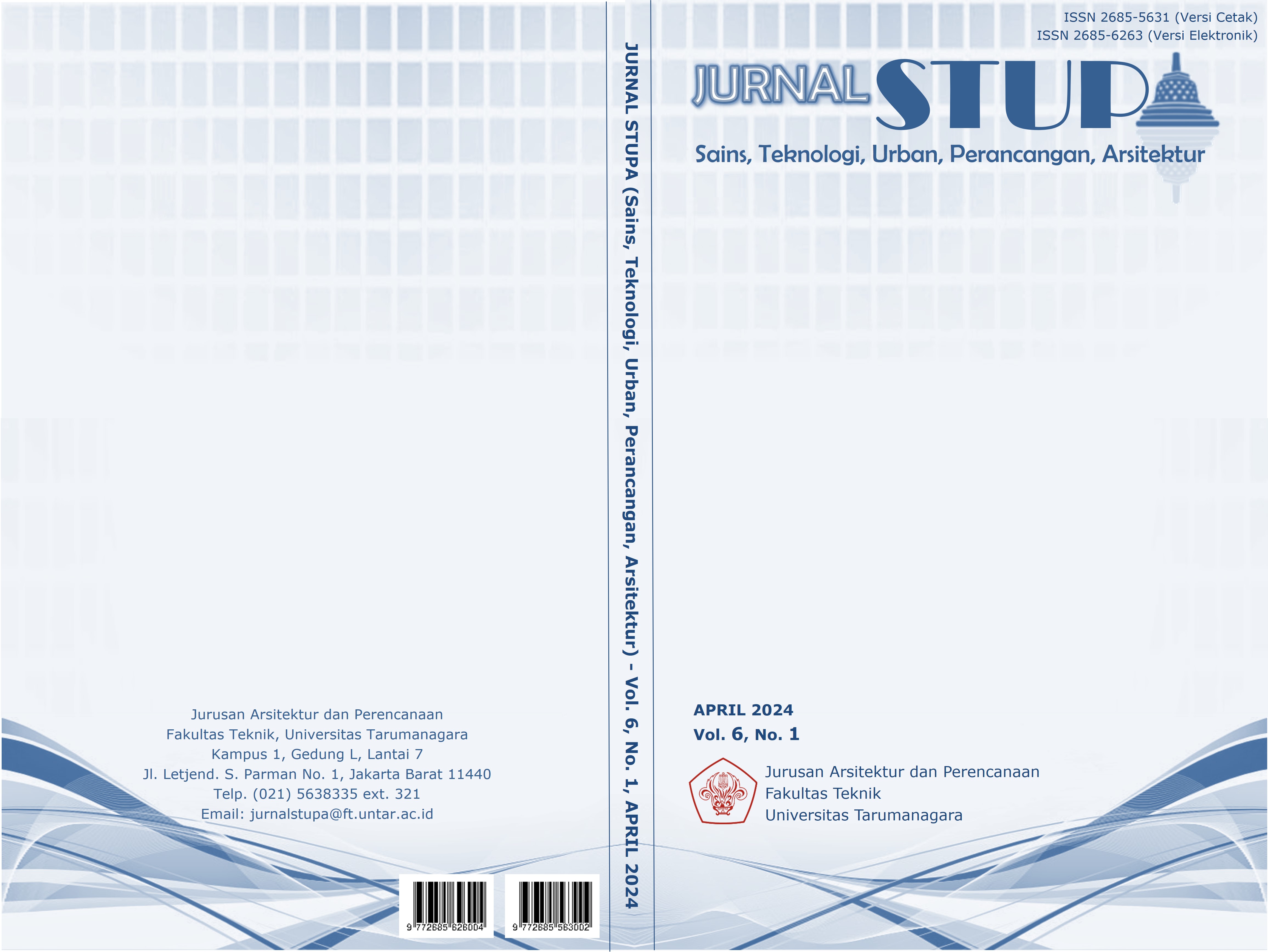HEALTHY GRIEFING DALAM ALUR NARASI SPASIAL SEBAGAI PENDEKATAN PERANCANGAN RUMAH DUKA DAN KREMATORIUM CILINCING, JAKARTA
Main Article Content
Abstract
Architectural empathy is architecture that puts itself in the user's position so that it can truly understand the user's needs. Grief is a natural reaction when facing the death of someone close to you. The grief process can be ongoing and have a negative impact on physical and mental health if it is not experienced in a healthy way. Empathy architecture here acts as a medium and space that understands the needs of users who are grieving. The aim of this research is to explore a design approach that is empathetic to the grief process, especially in the design process for renewing funeral homes and crematoriums in Cilincing using narrative qualitative research methods. Cilincing Crematorium is one of the oldest crematorium and funeral home facilities in Jakarta, its condition is no longer good and needs updating. The Healthy Grieving concept is a design concept that aims to guide users to grieve in a healthier way. The narrative method is used so that architecture can tell the story of the user's experience of grief so that the user can better understand the tragedy that is being experienced. Understanding these feelings of grief can help users navigate the grief process.
Keywords: crematorium; funeral home; healthy grieving; narration
Abstrak
Empati arsitektur adalah arsitektur yang menempatkan diri pada posisi pengguna sehingga dapat memahami betul kebutuhan pengguna. Duka adalah reaksi natural ketika menghadapi kematian dari orang orang terdekat. Proses duka dapat menjadi berkelanjutan dan berdampak buruk pada kesehatan fisik maupun mental apabila tidak dijalani dengan cara yang sehat. Arsitektur empati disini berperan sebagai suatu media dan ruang yang memahami kebutuhan pengguna yang sedang berduka. Tujuan dari penelitian ini adalah untuk menelusuri pendekatan perancangan yang berempati terhadap proses kedukaan terutama dalam proses perancangan pembaharuan rumah duka dan krematorium di Cilincing dengan menggunakan metode penelitian kualitatif naratif. Krematorium Cilincing adalah salah satu fasilitas krematorium dan rumah duka paling tua di Jakarta, kondisi nya sudah tidak baik dan diperlukan pembaharuan. Konsep Healthy Grieving adalah konsep perancangan yang bertujuan untuk memandu pengguna agar dapat berduka dengan cara yang lebih sehat. Metode naratif digunakan agar arsitektur dapat menceritakan pengalaman duka pengguna sehingga pengguna dapat lebih memahami tragedi yang sedang dijalani. Pemahaman terhadap perasaan duka tersebut dapat membantu pengguna untuk menjalani proses duka.
Article Details

This work is licensed under a Creative Commons Attribution-NonCommercial-ShareAlike 4.0 International License.
This work is licensed under a Jurnal Sains, Teknologi, Urban, Perancangan, Arsitektur/ STUPA Creative Commons Attribution-NonCommercial-ShareAlike 4.0 International LicenseReferences
Abalos, I., & Grau, U. (2010). Verticalism–The future of skyscraper. Ecological Urbanism. Lars Muller, Zurich, 610-615.
Agency, C. I. (2013). Country Comparison: Death Rate.
Archdaily. (2023). Crematorium Baumschulenweg / Shultes Frank Architeckten. Retrieved from Archdaily: https://www.archdaily.com/322464/crematorium-baumschulenweg-shultes-frank-architeckten
Archeyes. (2020, July 10). Kaze-no-Oka Crematorium / Fumihiko Maki. Retrieved from archeyes: https://archeyes.com/kaze-no-oka-crematorium-fumihiko-maki/
Architect Magazine. (2013, March 17). Meiso no Mori Municipal Funeral Hall. Retrieved from Architect Magazine: https://www.architectmagazine.com/project-gallery/meiso-no-mori-municipal-funeral-hall
Arradhika, D. D. (2012). Konsep Perencanaan dan Perancangan Taman Makam Vertikal di Jakarta.
Batson, C. D., Duncan, B. D., Ackerman, P., Buckley, T., & Birch, K. (1981). Is empathic emotion a source of altruistic motivation?. Journal of personality and Social Psychology, 40(2), 290.
Campbell, D. (2013). Six Feet Over: The Future of Skyscraper Cemeteries.
Funeralwise. (2023). The Cremation Process. Retrieved from Funeralwise.com: https://www.funeralwise.com/cremation/cremation-process/
Hariyono, W. P. (2015). Vertical cemetery. Procedia Engineering, 118, 201-214.
Hooyman, N., & Krammer, B. (2008). Living Through Loss: Interventions Across the Life Span.
Hunter, A. (2015). What Happens If Your Body Is Cremated According to Islam.
Kamboja.co.id. (2023). 9 Keuntungan Menggunakan Jasa Kremasi, Apa Sajakah Itu? Retrieved from Kamboja.co.id: https://kamboja.co.id/tips/jasa-kremasi/
Pallasmaa, J., Mallgrave, H. F., Robinson, S., & Gallese, V. (2015). Architecture and empathy. Finland: Tapio Wirkkala Rut Bryk Foundation.
Rogers, K. (2023, May 15). What the 5 stages of grief are, and how to get through them. Retrieved from CNN.
Sutanto, A. (2020). Peta Metode Desain. Jakarta: Universitas Tarumanagara.
Thompson, C. C. (2019). Honouring Loss: Using Mementos as Transitional Objects to Explore Ambiguous Loss.
Tikva, P. (2014). Israel Leads The Way With Vertical Burial Solutions After Lack Of Space.
Tionardus, M. (2022, October 7). Apa Itu Kremasi?. Retrieved from Kompas.com: https://entertainment.kompas.com/read/2022/09/07/111435266/apa-itu-kremasi?page=all
Waluyo, D., & Patnistik, E. (2021, November 16). 114 Makam yang Tertimbun Sampah di TPA Sumur Batu Mulai Dipindahkan Pemkot Bekasi. Retrieved from Kompas.com: https://megapolitan.kompas.com/read/2021/11/16/12571581/114-makam-yang-tertimbun-sampah-di-tpa-sumur-batu-mulai-dipindahkan
Zakiah, N. (2019, December 9). Tahukah Kamu? Ini 7 Tahap Terurainya Jasad Manusia saat Dikremasi. Retrieved from IDN Times: https://www.idntimes.com/science/discovery/nena-zakiah-1/tahap-terurainya-tubuh-manusia-saat-dikremasi
Zisook, S., & Shear, K. (2009). Grief and bereavement: what psychiatrists need to know. World psychiatry, 8(2), 67.



